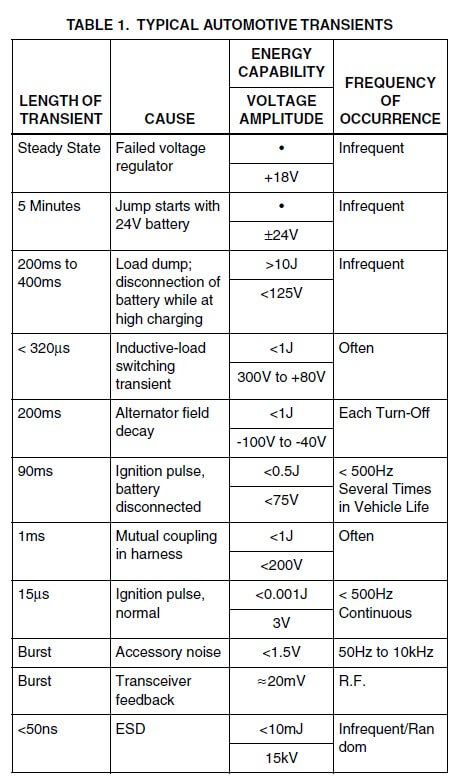Can a jump start damage computers?
Can a jump start damage computers or other electronics?
The simple answer is yes; jump-start damage is rare but real. I’m not talking about the kind of damage you can inflict by hooking up the jumper cables incorrectly. Crossing the jumper cables can blow a fuse or completely fry the vehicle’s computers. No, I’m talking about the kind of damage you can cause even if you follow proper jump-starting procedures.
Don’t believe me? Read this jump-start damage to alternator warning from the alternator manufacturer Valeo
“Battery power packs and jump-starting from another vehicle can cause damaging voltage spikes at the alternator. Multiple blown diodes on the rectifier are a confirmation that an external event has short-circuited the diodes. Alternators found to have all the diodes blown are not the result of a manufacturing defect and will not be covered by the warranty.” — Valeo Technical Bulletin TB005-19 Rev. 1
Then read this:
“The load dump overvoltage is the most formidable transient encountered in the automotive environment. It is an exponentially decaying positive voltage which occurs in the event of a battery disconnected while the alternator is still generating charging current with other loads remaining on the alternator circuit at the time of battery disconnect. The load dump amplitude depends on the alternator speed and the level of the alternator field excitation at the moment of battery disconnection. A load dump may result from a battery disconnect resulting from cable corrosion, poor connection or an intentional battery disconnect while the car is still running.
Or this jump-start damage to computers warning tidbit from the SAE
Independent studies by the Society of Automotive Engineers (SAE) have shown that voltage spikes from 25V to 125V can easily be generated [1], and they may last anywhere from 40ms to 400ms.“— Suppression of Transients in an Automotive Environment by Littlefuse.
All newer vehicles are vulnerable to jump-start damage to computers from voltage transients
Newer vehicles contain multiple computerized engines, powertrains, and transmission computers as well as computerized heater controls, ABS, Stability control, airbags, entertainment systems, memory seats, mirrors, pedals, etc. Just like your home electronics, these solid-state devices can be damaged by voltage spikes, RFI, and back EMF.
So, let’s start with an examination of how you get voltage spikes when you jumpstart a vehicle.
Connecting jumper cables with donor engine off
In this case, you’re connecting the jumper cables between a donor car that’s NOT running and a dead car (obviously not running). We’ll also assume that you’ll be connecting the cables correctly–positive to positive, negative to a good ground point.
As you move the jumper cable clamp closer to make the final connection, the voltage potential between the fully charged battery in the donor vehicle and the lower voltage in the dead battery results in a spark. This is due to breakdown voltage, where the ions in the air at the connection point become conductive. The spark is hot enough to ignite any hydrogen gas under the hood–which is why all car experts recommend making the last connection far from the battery.
In addition to the possibility of igniting hydrogen, the spark itself causes a voltage spike on the dead vehicle, along with electrical noise in the electrical systems of both vehicles.
Here’s a common scenario with a discharged battery
Once the battery in the dead vehicle drops below 9.6 volts, the computers and modules often shut down. But the instant you connect the jumper cables, the dead vehicle’s electrical systems “wake up” and draw current.
As the “hot at all times” ECM/PCM, body control module, remote keyless entry, and security system modules draw current, they activate or deactivate relays. Although this current draw is minor in comparison to the current drawn by the dead battery, the quick relay activation/deactivation can cause transient power surges in the dead vehicle’s electrical systems, as well as RFI interference and some degree of back EMF.
The voltage surges aren’t limited to just the dead vehicle’s electronics. Depending on the state of charge of the dead battery, a large voltage drop in the donor vehicle can cause that vehicle’s computers and relays to shut down and then re-awaken, causing the same types of voltage spikes.
How serious is the risk when neither engine is running? It’s pretty low if the dead battery is just slightly discharged but still above the 9.6-volt threshold, but it’s not zero. When the dead vehicle battery is above 9.6 volts, there’s a low voltage differential between the two vehicles. However, the chance of voltage spikes and damage increases as the voltage differential gap widens. In other words, the more discharged the dead battery, the larger the voltage differential between the donor and dead vehicle.
The possibility of jump start damage is much higher if the donor vehicle is running when the jumper cables are connected or disconnected.
Jumpstart damage to computers with donor engine running.
Now consider the possible jump-start damage to the computer when  the donor vehicle is running. The instant you make the final connection to the inductive load (dead battery), the donor vehicle experiences a voltage drop that’s directly related to the dead battery’s state of charge.
the donor vehicle is running. The instant you make the final connection to the inductive load (dead battery), the donor vehicle experiences a voltage drop that’s directly related to the dead battery’s state of charge.
In response to the voltage drop, the voltage regulator in the running alternator commands full-field excitation, which produces a short (320µS) transient voltage spike of 80 to 300-volts, more than enough voltage to damage the electronics in both vehicles. The voltage regulator recovers from the over-voltage situation by lowering field current to reach a safer charging voltage of around 15-volts or less.
Let’s assume the donor and dead vehicle’s electronics survive the extremely short voltage spike created when connecting the jumper cables and you leave the jumper cables connected to finish charging the dead vehicle. Here are the next three options:
1) Try starting the dead vehicles with the donor engine running and cables connected
2) Disconnect the jumper cables from the dead vehicle while the donor engine is running
3) Shut off the donor engine and disconnect the jumper cables before trying to start the dead vehicle.
In scenario #1, cranking the dead vehicle with the donor engine running causes the same cranking voltage drop and voltage regulator surge response (80-300-volt surge) as noted in the voltage drop chart above. That surge would more likely damage the donor vehicle’s electronics.
In scenario #2, disconnecting the jumper cables would cause the donor vehicle’s voltage regulator to load dump the field coil current, causing a voltage spike around 120-volts or less in that vehicle’s electrical system, an electronics damaging voltage spike.
Scenario #3 is the safest way to avoid generating a voltage spike when using jumper cables.
Is jump-start damage to computers a given?
No. There are too many other factors that can eliminate electronics damage, like the degree of surge protection built into the vehicle’s electronics, the condition of the surge protection components, and the degree of voltage differential between the jumping and dead battery.
But as you can see from these examples, the safest way to jump-start a dead vehicle is to connect the cables with both engines off. Then start the donor vehicle and let it run to charge up the dead battery and shut off the donor vehicle before trying to start the dead vehicle. Also, both vehicles should be shut down before removing the cables.
So, in effect, you’re using the good battery and alternator in the donor vehicle as a “jumper pack” to boost the dead battery.
However, even if you follow this safe procedure, you still have one issue to worry about: overheating the donor vehicle alternator. Alternator pulley speed is approximately three times crankshaft RPM, so it’s turning at 1,800 RPM at engine idle speed and 6,000 RPM as cruising speed. But an alternator can only output a maximum of 35% of its rated capacity at 1,800 RPM (600-700 engine idle RPM).
Worse yet, since many of these jump starts are conducted in winter conditions, it’s not uncommon for the donor vehicle to be using headlights or the blower motor. Here’s the current draw for these electrical accessories:
Headlights (low) 15-amps/20-amps high, Blower motor on high 20-amps, Ignition system 6-amps, Rear window defogger 25-amps, Heated seats 5-amps per seat.
So you commonly have a situation where the donor vehicle has its headlights on and possibly the blower motor while jumping the dead vehicle. In that case, the donor vehicle alternator is running at the maximum field at idle speed. That causes the field coil windings and rectifier diodes to overheat. The longer you run in this condition, the greater the chances of damaging the donor vehicle’s alternator.
Avoid jump-start damage by using a jumper pack
Using a jumper pack to start the dead vehicle eliminates some of the damaging conditions noted above. That’s because the jumper pack lowers the voltage differential (12-volts as opposed to up to 15-volts from the running donor vehicle). A jumper pack also eliminates the entire issue of voltage spikes and corresponding load dump spikes from the running alternator in the donor vehicle.
Connect the jumper pack cables just like you would regular jumper cables.
 Some jumper packs have an ON/OFF switch. In that case, just secure the positive clamp to the positive battery terminal and the negative clamp to a good metal ground.
Some jumper packs have an ON/OFF switch. In that case, just secure the positive clamp to the positive battery terminal and the negative clamp to a good metal ground.
If your jumper pack doesn’t have a switch, connect the positive clamp to the positive battery terminal and the negative clamp to a good ground.
Since the jumper pack contains a lead/acid battery, the jumping voltage is limited to 12.7 volts. So you won’t have a huge voltage spike like you might when jumping with a running donor car. That’s dramatically reduce the chance of blowing a computer.
Click HERE to learn how to buy a jumper pack
©, 2013 Rick Muscoplat
Posted on by Rick Muscoplat

